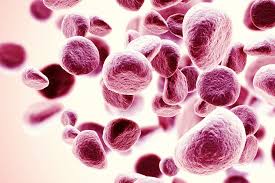Among patients with newly diagnosed multiple myeloma who were not eligible for a stem cell transplant, Darzalex (daratumumab), when added to the standard treatment of Velcade (bortezomib), Revlimid (lenalidomide) and dexamethasone (VRd), improved treatment response and reduced the amount of cancer left in the body, according to outcomes from the phase 3 CEPHEUS trial presented at the 2024 ASH Annual Meeting.
In addition, the combination led to improved progression-free survival (PFS), regardless of minimal residual disease (MRD) negative or positive status.
“These data support the use of [Darzalex] in combination with VRD as a normal standard of care in patients with newly diagnosed multiple myeloma who are transplant ineligible or when transplant is deferred,” Dr. Sonja Zweegman, Department of Hematology, Amsterdam UMC, Vrije Universiteit Amsterdam, Cancer Center Amsterdam, Netherlands, said during a presentation of the data.
After a median follow-up of 58.7 months, at a 10-5 sensitivity, the overall MRD-negativity rate was 60.9% for patients treated with Darzalex plus VRd (197 patients) versus 39.4% for those given VRd alone (198 patients). At a 10-6 sensitivity, the overall MRD-negativity rates were 46.2% for the Darzalex plus VRd arm versus 27.3% for the VRd arm.
“It can be appreciated … that adding Darzalex to VRd led to a 50% increase in MRD negativity,” Zweegman said.
Glossary:
Complete response: complete disappearance of cancer.
Minimal residual disease (MRD): small amount of cancer cells remaining after treatment.
MRD negativity: no detectable cancer cells remaining after treatment.
Progression-free survival (PFS): length of time a patient lives without disease worsening.
Subcutaneous: under the skin.
Thrombocytopenia: low platelet count, which can lead to easy bleeding.
Neutropenia: low neutrophil count, which can increase the risk of infection.
Peripheral edema: swelling in the arms or legs.
The 54-month PFS rates were 68.1% and 49.5%, respectively, reducing the risk for disease progression or death by 43%. Zweegman noted that the MRD negativity rates were generally consistent across prespecified subgroups.
When evaluating cumulative MRD negative complete response (CR) rates from the sensitivity level 10-5, patients reached MRD negativity faster, with higher rates at all time points. “And that the difference of the MRD negativity rates between the two groups are increasing up to three years,” Zweegman added.
This same effect was seen at the sensitivity level 10-6, which is even more related to PFS, she noted. “And importantly … [Darzalex] almost doubles the MRD negative CR rates that sustained for more than 12, 24 and 36 months.”
As sensitivity level 10-6, MRD-negative patients experienced superior PFS, compared with MRD-positive patients in both treatment arms. Further, the 54-month PFS rates for MRD-negative patients treated with Darzalex plus VRd or VRd alone were 86.2% and 79%, respectively. In MRD-positive patients, these rates were 51% and 36.5%.
“So [Darzalex] provides PFS benefit regardless of the MRD negativity CR status,” Zweegman said.
Additional Findings from CEPHEUS
The complete response (CR) or better rate was 81.2% in the Darzalex group versus 61.6% in the VRd group. In the Darzalex plus VRd group, the stringent CR, CR, very good partial response (PR) and PR rates were 65%, 16.2%, 11.7% and 4.1%, respectively. In the VRd group, these respective rates were 44.4%, 17.2%, 25.3% and 6.1%.
Regarding safety, grade 3/4 (severe/life-threatening) treatment-emergent AEs (TEAEs; side effects) occurred in 92.4% of patients in the Darzalex group versus 85.6% of patients in the VRd group. TEAEs led to discontinuation of all study drugs in 7.6% and 15.9% of patients, respectively.
The most common any-grade TEAEs included blood and lymphatic disorders (Darzalex arm, 82.7%; VRd arm, 64.6%), including neutropenia (55.8%; 39%), thrombocytopenia (46.7%; 33.8%) and anemia (37.1%; 31.8%); gastrointestinal disorders (79.7%; 81.5%), including diarrhea (56.9%; 59%) and constipation (38.1%; 42.1%); general disorders and administration-site conditions (80.7%; 75.4%), including peripheral edema (42.1%; 39%) and fatigue (32%; 30.8%); psychiatric disorders (46.2%; 49.2%), including insomnia (32%; 32.3%); infections (91.9%; 85.6%), including upper respiratory tract infection (39.6%; 32.8%) and COVID-19 (38.1%; 24.6%); and second primary malignancies (7.6%; 9.2%).
MRD Negativity as an End Point
“We all know that MRD negativity is associated with longer survival, and it's a strong prognostic for clinical end points in multiple myeloma and a key goal of multiple myeloma therapy,” Zweegman explained. “And therefore, MRD negativity was supported by the [FDA Oncologic Drugs Advisory Committee] as an early end point for accelerated approval in multiple myeloma.”
The phase 3 CEPHEUS trial was the first phase 3 study of Darzalex with MRD as a primary end point. In the trial, investigators demonstrated that the addition of subcutaneous Darzalex with VRd in patients with transplant-ineligible or transplant-deferred newly diagnosed multiple myeloma led to superior rates of overall and sustained MRD negativity, as well as more CR and it significantly improved PFS.
At the 2024 ASH Annual Meeting, Zweegman reported on an expanded analysis of MRD outcomes from the CEPHEUS trial.
In the trial, investigators randomly evenly assigned patients to receive Darzalex at 1800 milligrams (mg) once per week in cycles 1 and 2, then once every three weeks in cycles 3 to 8, plus 1.3 mg per square meter (mg/m2) of Velcade on days 1, 4, 8 and 11 of each 21-day cycle; 25 mg of Revlimid on days 1 to 14 of each cycle, and 20 mg of dexamethasone on days 1, 2, 4, 5, 8, 9, 11 and 12 of each cycle for eight cycles; or VRd alone at the same dosing schedule. Starting in cycle 9, patients in the experimental arm received 1800 mg of Darzalex once every four weeks plus 25 mg of Revlimid on days 1 to 21 and 40 mg of dexamethasone on days 1, 8, 15, and 22 of each 28-day cycle; those in the control arm received Rd at the same dosing schedule.
The overall MRD-negativity rate with a CR or better served as the trial’s primary end point. Secondary end points included PFS; the proportion of patients with sustained MRD negativity with a CR or better for at least 12 months; and CR or better rate.
References:
- “Phase 3 Randomized Study of Daratumumab (DARA) + Bortezomib, Lenalidomide and Dexamethasone (VRd) Versus Alone in Patients with Transplant-Ineligible Newly Diagnosed Multiple Myeloma or for Whom Transplant Is Not Planned As Initial Therapy: Analysis of Minimal Residual Disease in the Cepheus Trial” by Dr. Sonja Zweegman et al., Blood.
- “Daratumumab SC + bortezomib/lenalidomide/dexamethasone in patients with transplant-ineligible or transplant-deferred newly diagnosed multiple myeloma: results of the phase 3 CEPHEUS study” by Dr. Saad Usmani, Blood.
For more news on cancer updates, research and education, don’t forget to subscribe to CURE®’s newsletters here.






